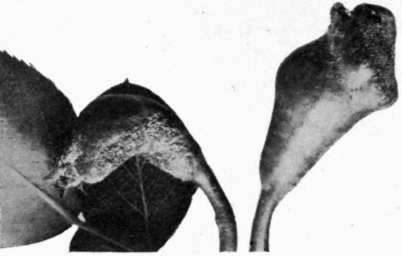Pear Pacific Coast Rust, Caused By Gymnosporangium Libocedri (P. Henn.) Kern = G. Blasdaleanum (Diet. And Holw.) Kern
Description
This section is from the book "Manual Of Fruit Diseases", by Lex R. Hesler. Also available from Amazon: Manual Of Fruit Diseases.
Pear Pacific Coast Rust, Caused By Gymnosporangium Libocedri (P. Henn.) Kern = G. Blasdaleanum (Diet. And Holw.) Kern
This is one of the recently recognized rusts of the pear family. The name Pacific Coast rust is used in contradistinction to eastern rust of pear (see page 341). The disease here considered was discovered in Oregon on cultivated pear several years ago, but was first given special attention in 1907. Since that date it has been found annually in Oregon and was particularly abundant in 1913. It is believed on good authority that this rust will in time become one of the most important pear troubles within its present range. It is most common on the native hosts, Oregon crab and its apple-hybrids, the hawthorn and service-berry. It also occurs on the ornamentals mountain - ash, Japanese quince, Japanese pear and flowering crab. It is common on the cultivated quince, but is rare on the cultivated apple.
Symptoms
The foliage (Fig. 95), fruit (Fig. 96) and stems are affected, and in each case there results some distortion. Yellow or orange spots develop on the affected parts; within the discolored area cup-like bodies with white margins are visible to the unaided eye. The fungus affects the incense cedar (Libocedrus decurrens), symptoms showing as brownish pustules on the leaves (Fig. 97). Sometimes Witches Brooms are formed; these may attain a diameter of two feet. Cause.

Fig. 95. - Pacific Coast rust on pear - leaves.

Fig. 96. - Pacific Coast rust on pear - fruit.
The Pacific Coast rust fungus may properly be called Gymnosporangium Libocedri. Sporidia developed from teliospores on the incense cedar are blown for a considerable distance to the pear and other pomaceous fruits, where they cause infection. Within a few days after the pear is inoculated by sporidia, spots become visible on the affected organ as a result of infection. Within a month or less after inoculation mature aecia are present. From the aecia great numbers of aeciospores are produced. These are liberated and are carried by the wind to the incense cedars, where infection results. The mycelium of the fungus commonly stimulates the cedar to Witches Broom formation. Here in these tissues of the cedar the mycelium is perennial, the tissues retaining the fungus year after year without being infected anew by seciospores from a pomaceous host.

Fig. 97. - Pacific Coast rust of pear; telial stage on incense cedar.
Control
It is suggested that pear scab sprayings (see page 335) probably would reduce this disease. Incense cedars should be removed where they are not highly valued, and pear - growers should avoid planting them. As a rule, however, this practice is unpopular, inasmuch as these trees are a valuable forest crop.
References
Jackson, H. S. A Pacific Coast rust attacking pear, quince, etc.
Oregon Crop Pest and Hort. Bienn. rept. 1913-1914:204 - 212.
1915. Jackson, H. S. A new pomaceous rust of economic importance, Gymnosporangium Blasdaleanum. Phytopath. 4: 261-269. 1914. O'Gara, P. J. A rust - new on apples, pears, and other pome fruits.
Science, 39: 620 - 621. 1914.
Continue to:


